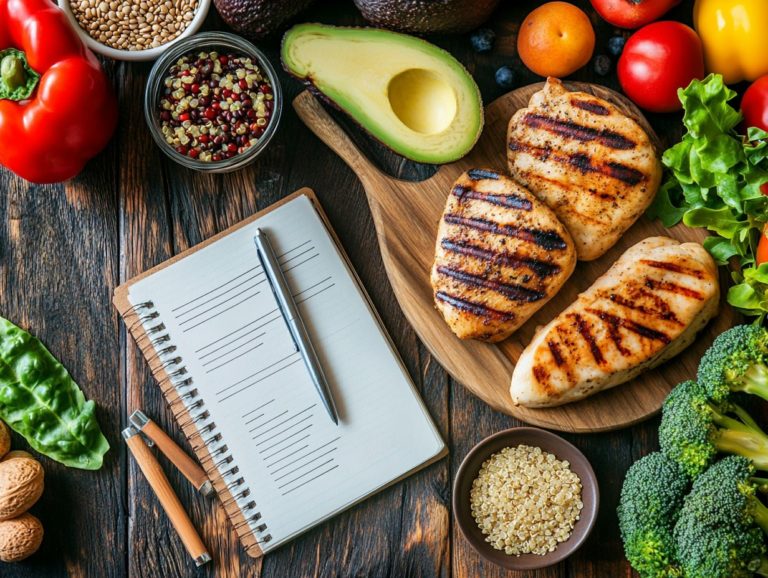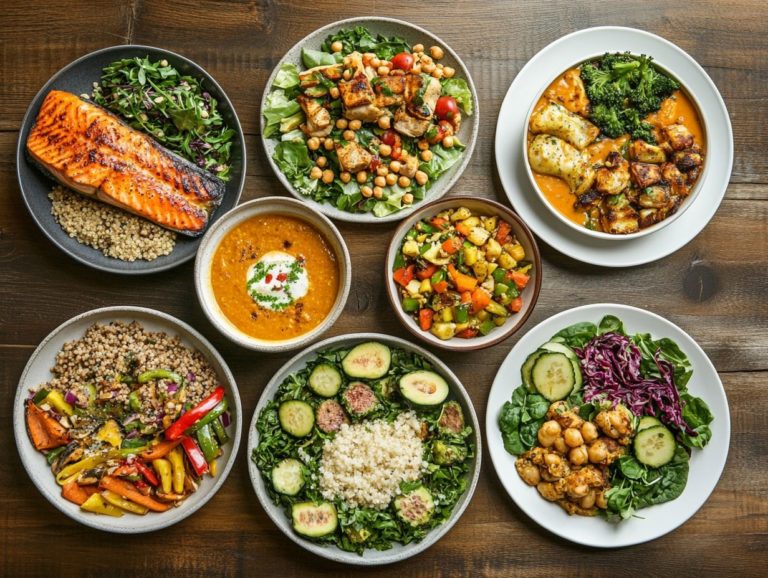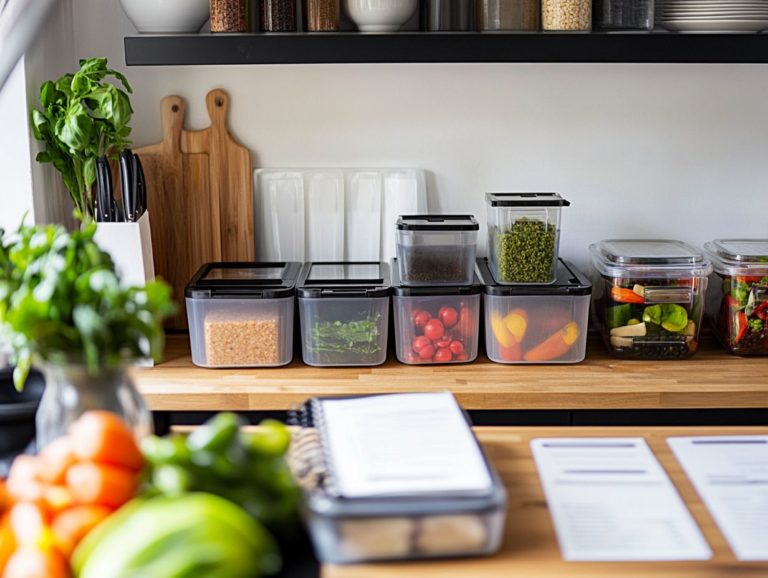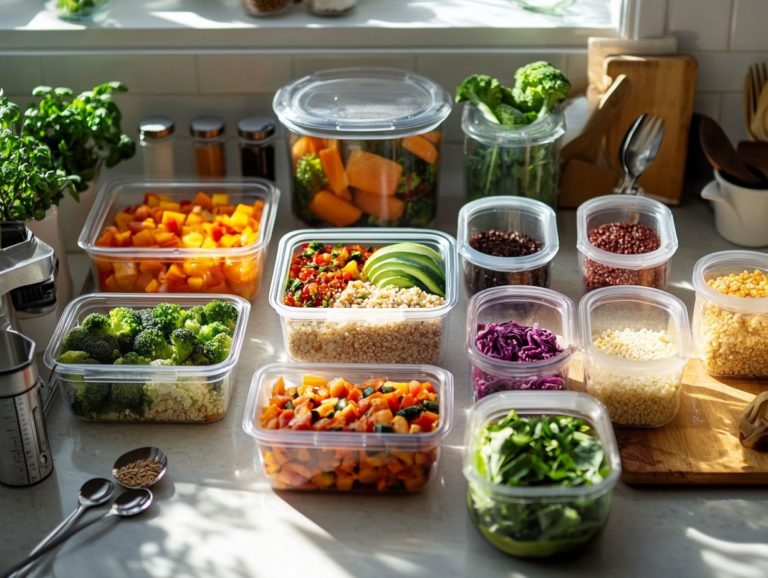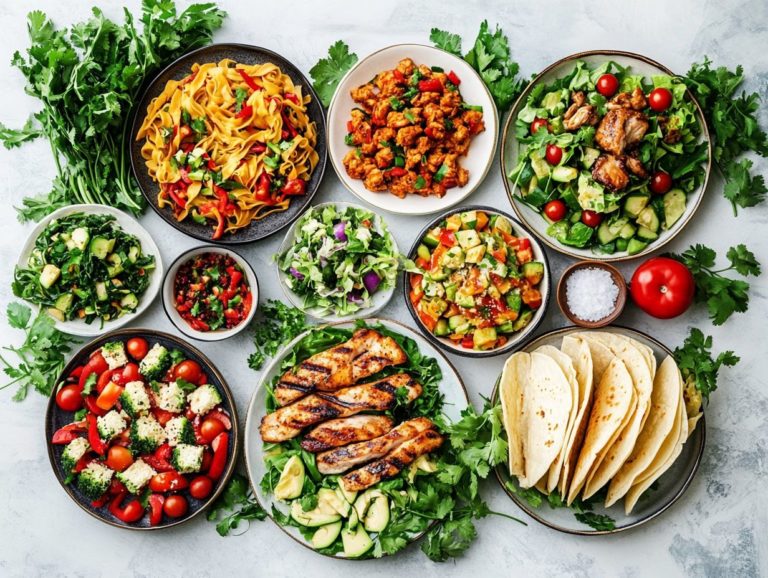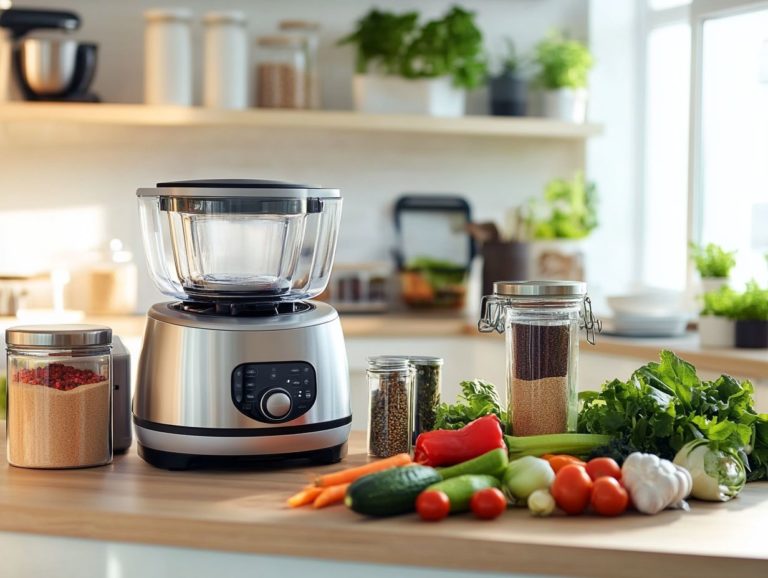5 Tips for Planning Healthy Work Lunches
Struggling to strike the perfect balance between convenience and nutrition for your work lunches? You re definitely not alone in this!
This article dives into five essential tips that will empower you to plan healthy lunches that not only fuel your body but also tantalize your taste buds.
From selecting nutrient-dense foods and adding vibrant colors to your meals, to mastering the art of meal prepping and ensuring your snacks are equally nutritious, this guide gives you all the tips you need.
Discover how a touch of planning can revolutionize your lunch routine into a delightful and healthful experience. Let s transform your work lunches today!
Contents
- Key Takeaways:
- 1. Choose Nutrient-Dense Foods
- 2. Incorporate a Variety of Colors
- 3. Plan Ahead and Prep Meals
- 4. Pack Balanced Meals
- 5. Don’t Forget About Snacks
- Why Is It Important to Plan Healthy Work Lunches?
- Frequently Asked Questions
- What are the benefits of planning healthy work lunches?
- What are some tips for planning healthy work lunches?
- How can I make meal prepping for work lunches more efficient?
- What are some budget-friendly options for healthy work lunches?
- How can I ensure that my work lunches are balanced and nutritious?
- Exciting ideas for healthy work lunches that you can whip up in no time!
Key Takeaways:
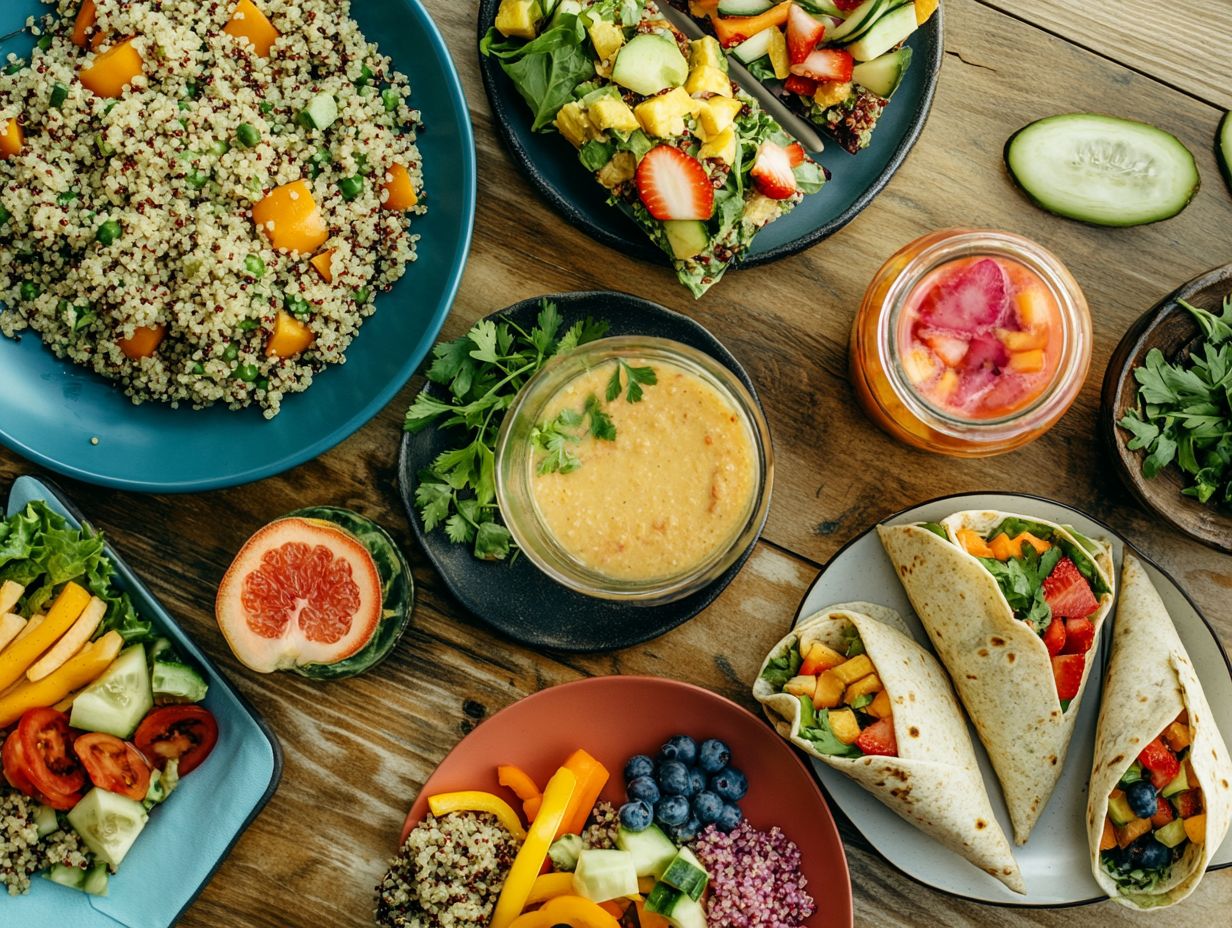
- Choose nutrient-dense foods to fuel your body with essential vitamins and minerals for a productive work day.
- Incorporate a variety of colorful foods to reap the health benefits of a diverse range of nutrients.
- Plan ahead and prep your meals to save time and ensure you have healthy options available.
1. Choose Nutrient-Dense Foods
Nutrient-dense foods are essential for crafting a healthy lunch that energizes both your body and mind, making it easier for you to tackle daily tasks with enthusiasm and vitality. Focus on foods rich in protein, healthy fats, and vitamins to create meals that are satisfying and beneficial for your overall well-being.
Incorporating options like quinoa, beans, chicken, spinach, and avocado into your lunch ensures that your packed meal is both nutritious and delicious.
These food choices provide a great source of long-lasting energy, which is vital for maintaining your concentration and productivity throughout the day.
For instance, quinoa is a flexible ingredient you can use in many dishes and is loaded with essential amino acids, making it an excellent protein source. Beans deliver fiber and complex carbohydrates that help stabilize your blood sugar levels. Chicken, with its lean protein, supports muscle repair and growth essential for your active lifestyle.
Spinach is packed with iron and natural compounds in plants that are good for your health, bolstering your immune system, while avocado, rich in healthy fats and fiber, promotes heart health and keeps you feeling full longer.
By embracing these nutrient-dense foods, you can significantly enhance both your physical and mental performance.
2. Incorporate a Variety of Colors
Incorporating a variety of colors into your healthy lunch not only elevates the visual appeal but also boosts its nutritional profile. Colorful foods are typically rich in essential vitamins and antioxidants that contribute to your overall health.
By including a spectrum of fruits and vegetables in your meal prep, you can diversify your nutrient intake while keeping your packed lunch interesting and exciting.
For instance, vibrant bell peppers offer a satisfying crunch along with a hefty dose of vitamin C, while deep-hued spinach is a powerhouse of iron and vital natural compounds in plants that are good for your health.
Mixing in bright orange carrots introduces beta-carotene, which is crucial for eye health, and those vibrant blueberries are brimming with antioxidants that support brain function.
These colorful additions do more than please the eye; they can transform a simple salad or grain bowl into a nutritional powerhouse, enhancing your overall well-being and vitality.
3. Plan Ahead and Prep Meals
Effective meal prep and planning are essential for ensuring you have a healthy lunch during hectic workdays. This proactive approach helps you avoid last-minute unhealthy choices and encourages better eating habits.
Set aside time to prepare meals in advance using healthy ingredients like hearty soups, rice salads, and protein pots. You ll save time and enjoy balanced, nutritious meals. Get creative with leftovers to enhance your meal planning strategy and maximize what you already have on hand.
This method supports your nutritional goals and gives you control over your eating choices, steering you clear of impulsive purchases. Designate a specific day each week for meal prep. Chop vegetables, marinate proteins, and portion out snacks. Simple recipes like quinoa bowls with roasted vegetables or chickpea salads offer variety and essential nutrients, turning lunchtime into an occasion you look forward to.
By consistently preparing meals, you ll love having delicious, ready-to-eat options in your fridge that align perfectly with your health goals!
4. Pack Balanced Meals
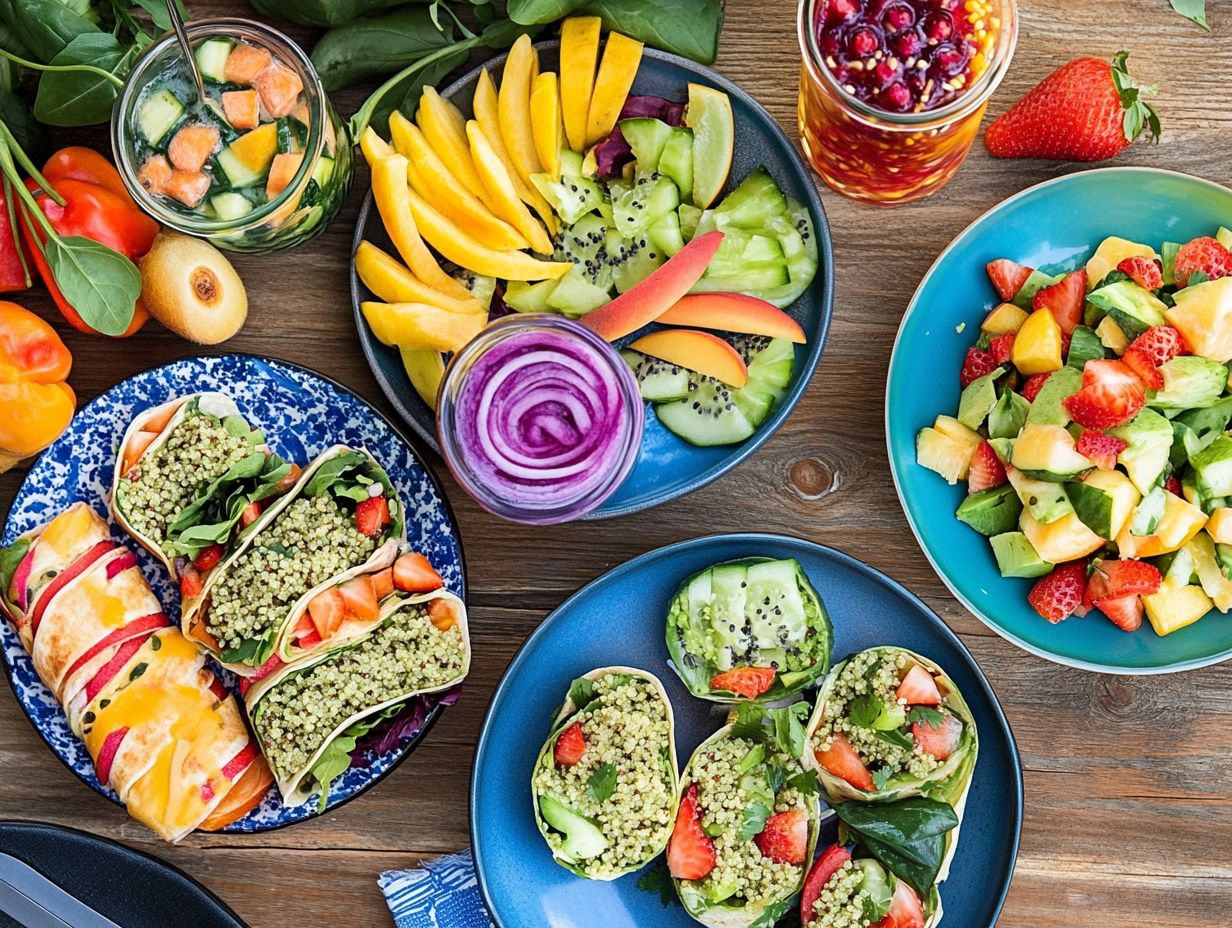
Packing balanced meals is crucial for maintaining your energy levels and promoting overall health. A balanced meal typically features a source of protein, grains, and a medley of fruits and vegetables, ensuring you receive the nutrients you need.
Incorporate items like homemade wraps, grain bowls, and vibrant salads to keep your lunches fresh and exciting. Planning your meals in advance saves you time and ensures proper distribution of food groups.
Imagine a well-proportioned bowl that combines quinoa, a nutritious grain packed with protein, with grilled chicken or chickpeas, and a colorful array of veggies like bell peppers and spinach. Preparing a batch of these grain bowls at the start of the week allows for quick assembly each morning.
Don t shy away from experimenting with flavors and textures adding creamy avocado or your own homemade dressings can elevate a simple lunch into a delightful culinary experience that keeps you satisfied.
5. Don’t Forget About Snacks
Incorporating healthy snacks into your daily routine is just as vital as planning a nutritious lunch. These little power-ups help maintain your energy levels and provide essential nutrients throughout the day.
A well-chosen snack can bridge the gap between meals, warding off that notorious mid-afternoon slump. Opt for snacks rich in fiber, like a handful of nuts or a serving of yogurt with berries, which fosters sustained energy release and keeps hunger at bay.
Choosing portable snack options, such as whole-grain crackers or sliced vegetables with a light dip, makes fueling up on-the-go easy. This mindful snacking complements your lunch and bolsters your overall well-being, making it easier to stay on track with your dietary goals.
Why Is It Important to Plan Healthy Work Lunches?
Planning healthy work lunches helps maintain your energy and boosts productivity. A nutritious meal significantly impacts your focus and efficiency. By prioritizing balanced meals that include proteins, whole grains, and a colorful array of fruits and vegetables, you fuel your body and support hydration and cognitive function. This makes meal planning vital for a successful work routine.
When you take the time to thoughtfully plan your lunches, you will notice improvements in your decision-making and a decrease in stress levels. Healthy lunches help stabilize your blood sugar, reducing those dreaded afternoon slumps and irritability that can hinder both your personal performance and collaboration with colleagues.
Incorporating regular, healthy lunches lays the groundwork for better eating habits and encourages you to explore a variety of food options. This leads to a more balanced diet overall. Such shifts often result in lasting lifestyle changes that contribute to long-term health benefits, such as lowered cholesterol, improved cardiovascular health, and enhanced mood stability.
What Are Some Examples of Nutrient-Dense Foods?
Nutrient-dense foods are rich in nutrients without too many calories. Think of proteins like chicken and beans, alongside wholesome grains such as quinoa, and a colorful array of fruits and vegetables.
These foods boost your physical health and elevate your mood! By incorporating leafy greens like spinach and kale, you add valuable fiber and antioxidants to your meals. Berries, such as blueberries and strawberries, are tasty snacks that are high in vitamins C and K.
Consider adding legumes like lentils or chickpeas to your soups and salads; they re fantastic for boosting your protein intake and keeping you feeling satisfied longer. Swapping out refined grains for heartier options like brown rice or farro at lunch enhances your meals with additional nutrients.
By weaving a variety of these choices into your daily meals, you create a balanced and nutritious approach to eating that supports overall well-being.
How Can Colorful Foods Benefit Your Health?
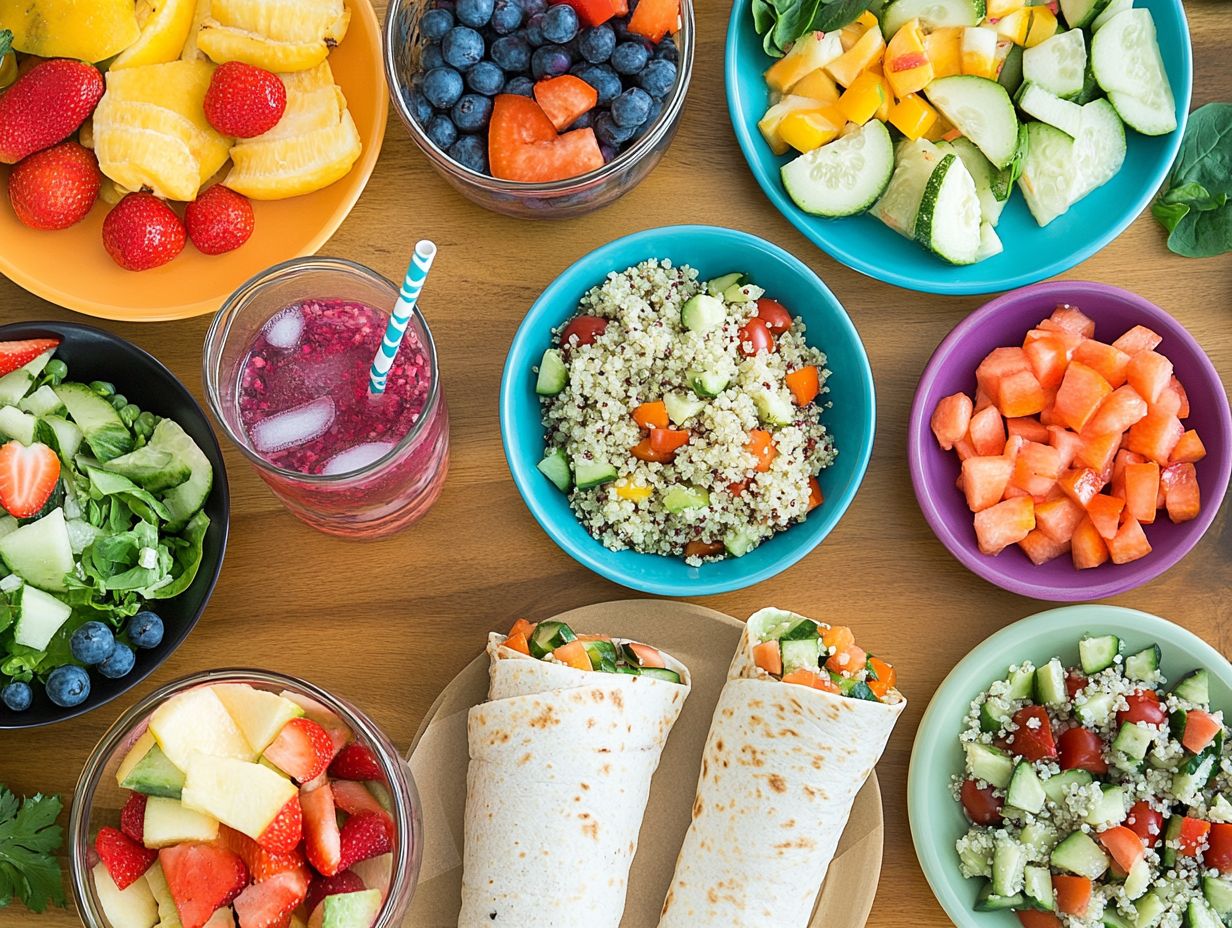
Colorful foods, such as vibrant fruits and vegetables, offer lots of health benefits due to their rich vitamins, minerals, and antioxidants. These essential nutrients play a crucial role in disease prevention and overall wellness. By adding a variety of colors to your healthy lunch, you enhance its visual appeal and maximize the nutritional impact of each meal.
Take leafy greens like spinach they’re packed with iron and calcium. Bright bell peppers deliver a generous dose of vitamin C. Incorporating a rainbow of produce into your lunch can be as effortless as tossing together a mixed salad featuring purple cabbage, orange carrots, and juicy tomatoes, all drizzled with a zesty vinaigrette.
For snacks, think about vibrant options like a smoothie made with blueberries, kale, and mango, or fresh vegetable sticks paired with a roasted red pepper hummus dip. Start including these colorful foods today to boost your health!
What Are Some Tips for Meal Planning and Meal Prep?
Effective meal planning and preparation can transform your cooking routine. It makes it easy to whip up healthy lunches while saving time and reducing waste. One effective strategy is to get creative with leftovers. Dedicating just a few hours each week to prepare meals ahead of time ensures a steady supply of nutritious options for busy days when time is scarce.
To enhance your efficiency, start by choosing versatile ingredients that can shine in multiple recipes. Think of nutritious grains like quinoa, beans, and seasonal vegetables. Planning meals that lend themselves to large batches, like hearty soups or comforting casseroles, not only saves time but guarantees you ll always have something wholesome on hand.
Consider setting aside one day for your prep work. You can chop, cook, and portion your meals all in one go. Using containers for individual servings makes meals easy to grab, ensuring a nutritious diet throughout the week.
What Does a Balanced Meal Consist of?
A balanced meal is your ticket to essential nutrients and energy. It typically features a protein source, whole grains, and a mix of fruits and vegetables. When crafting your healthy lunch, think about incorporating options like hearty soups, vibrant rice salads, and homemade wraps that embody these essential components for both satisfaction and nourishment.
To thoughtfully integrate each component, begin with a protein source grilled chicken, chickpeas, or tofu work wonderfully. Pair this with whole grains like quinoa or brown rice, which provide texture and that all-important fiber.
A colorful array of vegetables can elevate both the visual appeal and nutrient profile of your meal. Consider adding spinach, bell peppers, or cherry tomatoes for a burst of color and flavor.
For a quick and satisfying option, imagine a Mediterranean grain bowl filled with farro, roasted veggies, and grilled shrimp. It checks all the boxes for a balanced meal and can be assembled in no time, making it an ideal choice for your busy lunch hour!
Why Are Snacks Important for a Healthy Work Lunch?
Snacks play a vital role in keeping your energy levels up and hunger at bay throughout the workday. They are essential for a well-rounded lunch plan. By incorporating nutritious options like fruits, vegetables, and protein-rich choices such as hummus, you can boost your hydration and focus, enhancing both productivity and overall well-being.
These little additions effectively bridge the gap between meals and help you avoid those dreaded afternoon slumps that often follow a hefty lunch. To maintain steady energy, consider easy-to-pack options like yogurt cups, mixed nuts, or whole-grain crackers paired with cheese perfect choices that won t weigh you down!
Fresh cut veggies like carrots and celery, especially when paired with guacamole or a light dip, add a satisfying crunch and deliver essential nutrients. Making these simple adjustments to your daily routine can lead to improved concentration and a more fulfilling workday experience!
Frequently Asked Questions
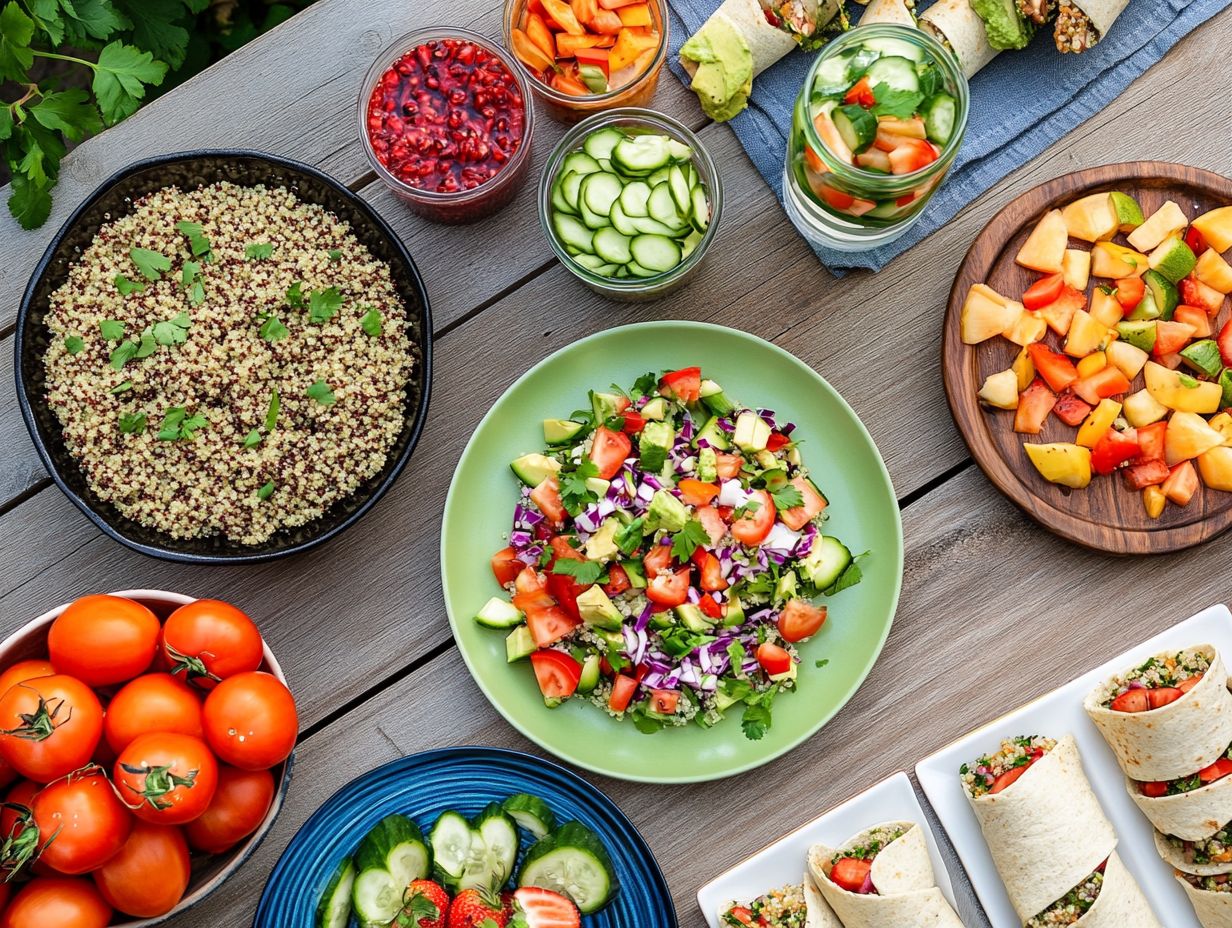
What are the benefits of planning healthy work lunches?
Planning healthy work lunches can save time and money. It promotes a more nutritious diet, increases energy and productivity, and reduces the temptation to make unhealthy food choices.
What are some tips for planning healthy work lunches?
- Prepare meals ahead of time.
- Incorporate a variety of fruits and vegetables.
- Choose lean protein sources.
- Opt for whole grains.
- Pack snacks to avoid mid-day hunger.
How can I make meal prepping for work lunches more efficient?
To make meal prepping for work lunches more efficient, try batch cooking on weekends, investing in quality storage containers, and planning meals that can be easily reheated or eaten cold.
What are some budget-friendly options for healthy work lunches?
Some budget-friendly options for healthy work lunches include making your own salads or sandwiches, packing leftovers from last night’s dinner, or choosing canned or frozen fruits and vegetables.
Ready to simplify your lunches? Start meal prepping this weekend!
How can I ensure that my work lunches are balanced and nutritious?
Include lean protein (like chicken, turkey, or tofu), complex carbohydrates, healthy fats, and a variety of fruits and vegetables in your lunch. This mix will keep you energized and satisfied.
Exciting ideas for healthy work lunches that you can whip up in no time!
Try salads in jars, wraps or sandwiches made with whole grain bread, veggie and hummus platters, or yogurt parfaits topped with fresh fruit and granola.
These options are not only tasty but also easy to prepare!

